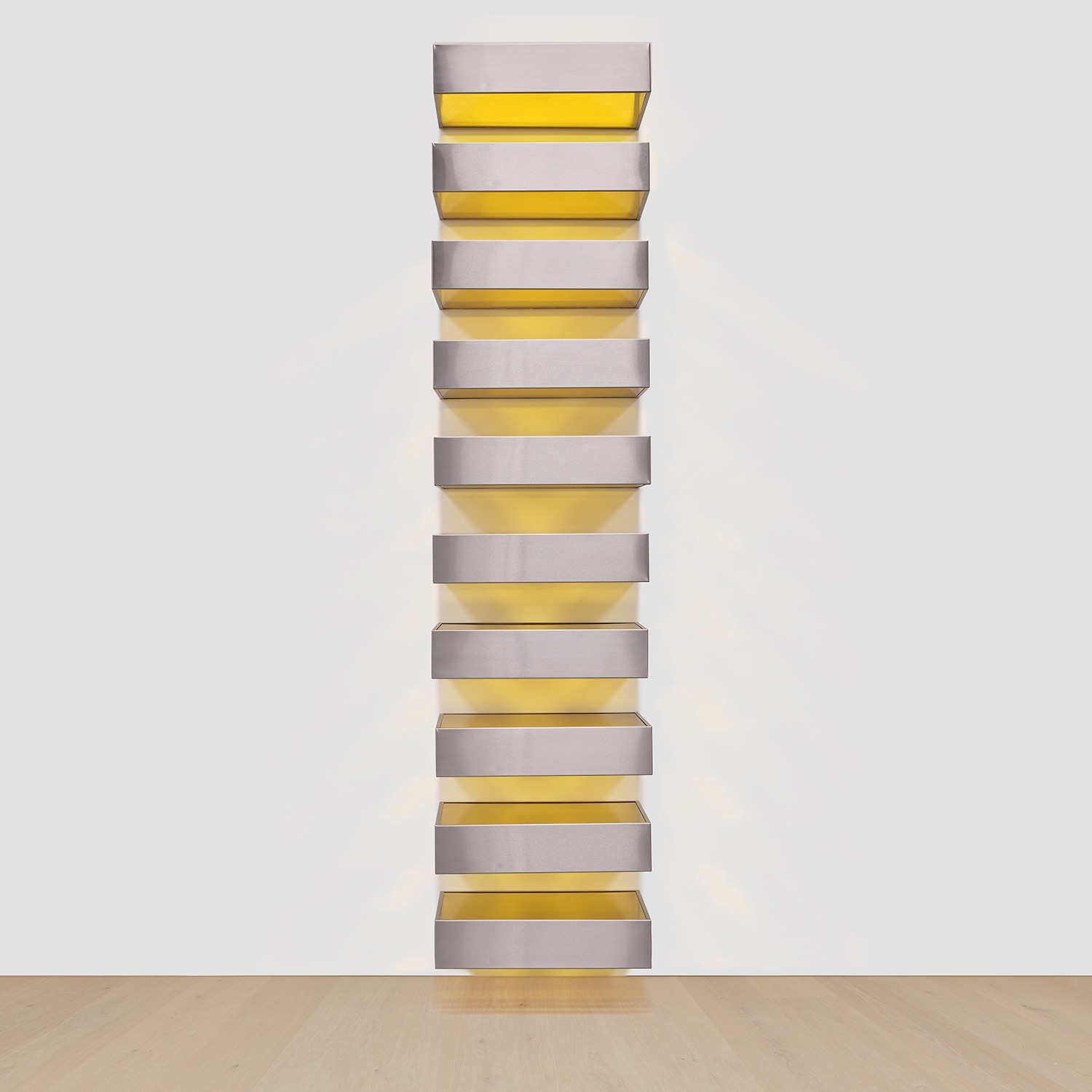
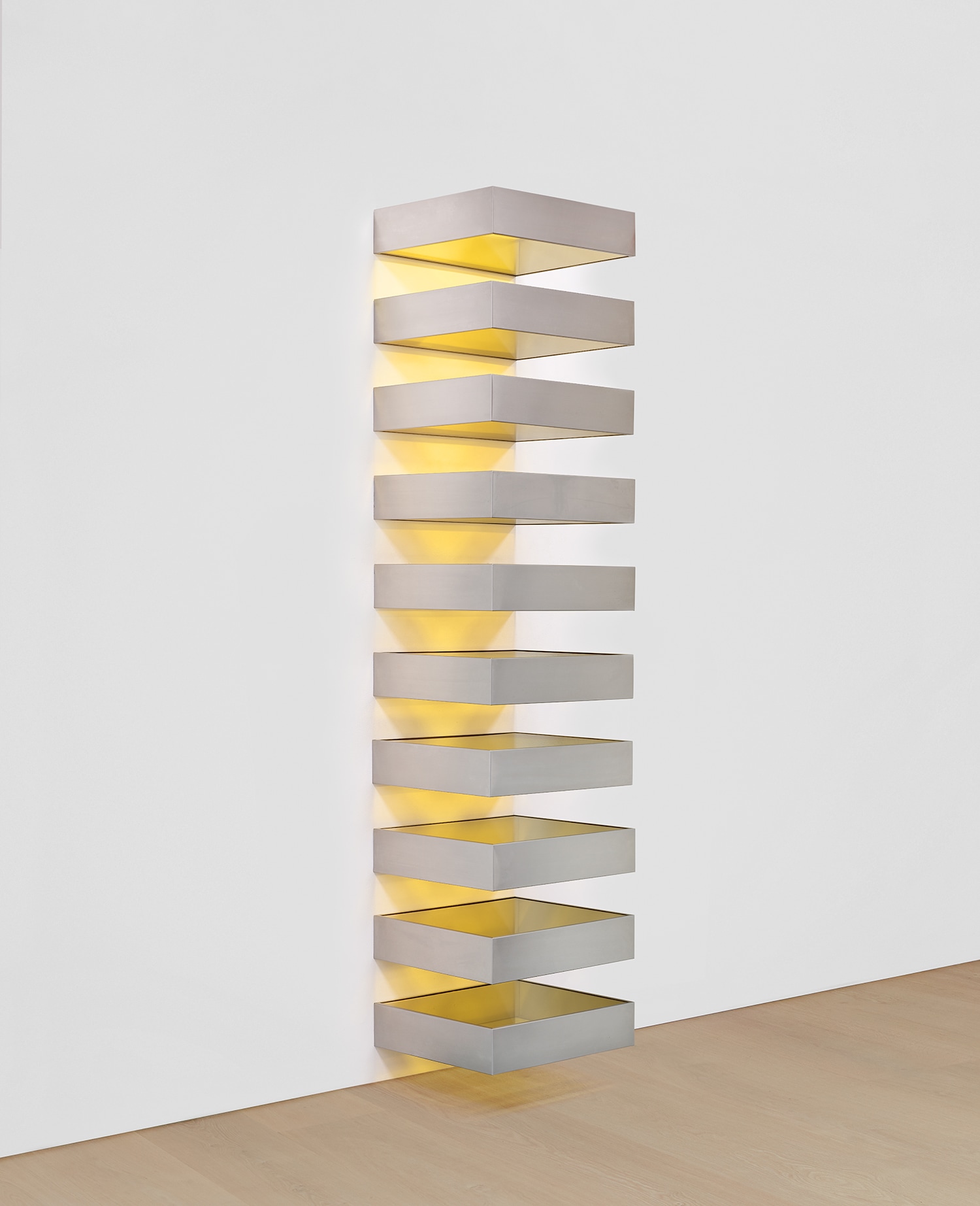
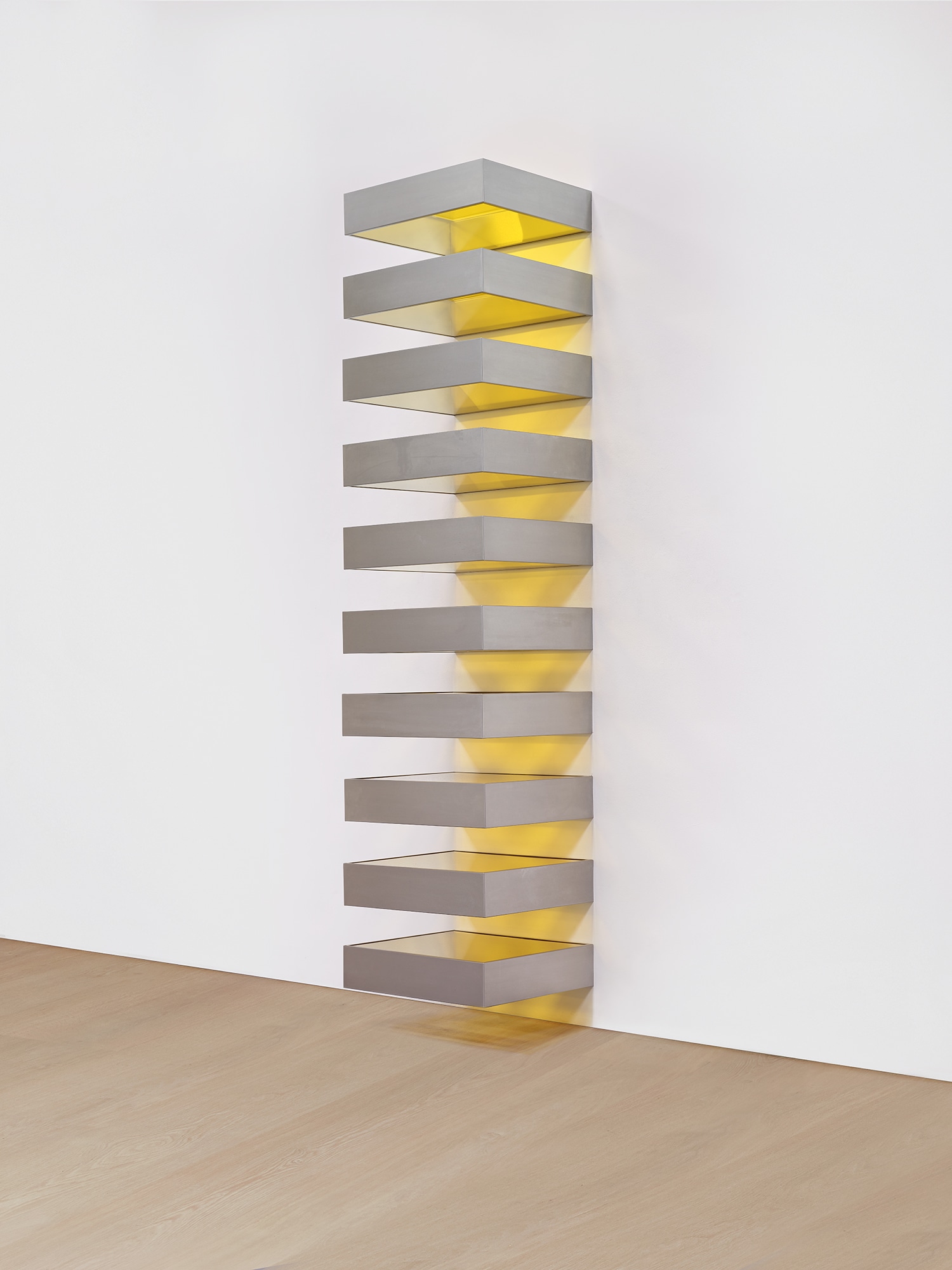
12Ο◆
Donald Judd
Untitled
- Estimate
- $5,500,000 - 7,500,000
installation dimensions 122 1/2 x 27 x 24 in. (311.2 x 68.6 x 61 cm)
Further Details
“I’m interested in ideas I can work with, and the stack proved to have a lot of possibilities.”
—Donald Judd
Found in almost every major museum collection across the world, Donald Judd’s stacks are a cornerstone of post-war American art, embodying the radical redefinition of art and form that characterized the emergence of Minimalist aesthetics. Though the artist did not like the term—preferring to call himself an “empiricist”—his breathtakingly austere forms and meticulous attention to materiality exemplified a profound commitment to clarity, precision, and the inherent qualities of objecthood. Executed in 1978, Untitled showcases the evocative power of Judd’s mature approach in his most iconic format. The work’s ten stainless steel and flourescent yellow Plexiglas units invite viewers to explore the interplay of light, color, and form—hallmarks of Judd's interrogation of the nature of perception. Disinterested in the emotive heights of Abstract Expressionism and representational art, Judd viewed painting and sculpture as stagnant “set forms,” prompting his 1965 treatise “Specific Objects.” He saw art as objects intriguing for their specificity and phenomenological value, surpassing conventional categorizations like “sculpture.”i This manifesto is encapsulated in Untitled, a powerful expression of Judd’s signature aesthetic and the conceptual rigor of his practice at the height of his career.
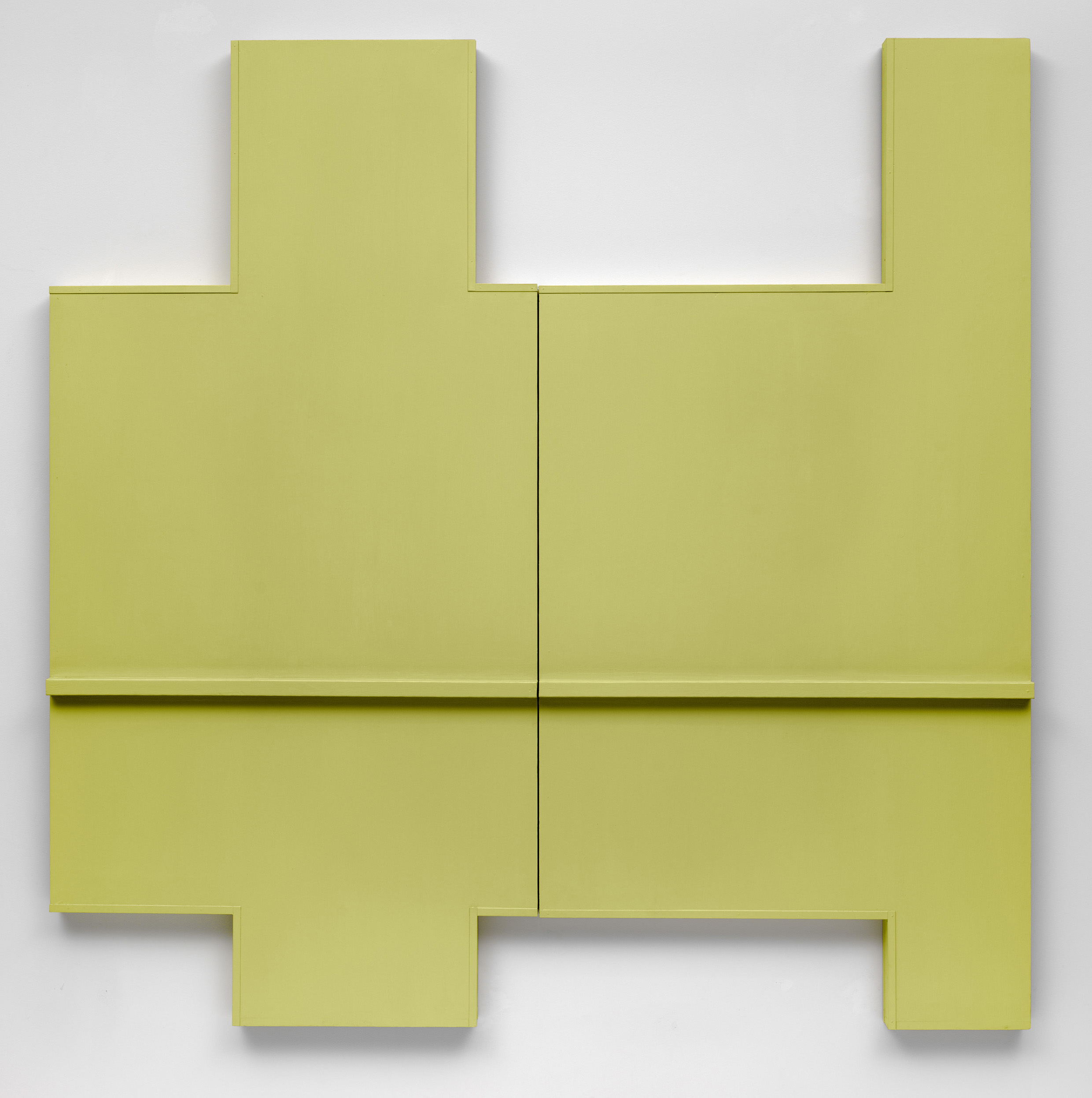
Robert Mangold, Yellow Wall (Section I + II), 1964. The National Gallery of Art, Washington, D.C. Image: The National Gallery of Art, Washington, D.C., The Nancy Lee and Perry Bass Fund, 2004.124.1, Artwork: Artwork: © 2024 Robert Mangold / Artists Rights Society (ARS), New York
When Judd executed his first stack in 1965, it marked a breakthrough in the artist’s thinking about art and objecthood. The work realized his aim of integrating space, alongside color and form, as a fundamental material in his practice. As with the present example, these stacks were most often comprised of ten units and are installed to ensure that the interval between each unit equals their volume. This format establishes a staccato rhythm between positive and negative space which begins to erode the ostensibly clear distinction separating presence and absence. The stacks also allowed Judd to achieve a radical abstraction that his peers, including David Smith and Mark di Suvero, could not: by being hinged to a wall, they eluded many of the illusionistic conventions commonly associated with sculpture. Indeed, as Judd explained in an interview, in 1971 “the stack going from floor to ceiling and the fact that it’s not a column and not resting on its base saves it from that figurative business.”ii Captivated by the form for the rest of his life, he continued experimenting with differences in color, size, and material for nearly three decades.
“The effect is astonishing: color glows in the interstices and, seen as a whole, the vertical stacks look like gently gleaming columns; yet the actual structures appear so light that the metal bands seem to do no more than contain the color radiating outward.”
—Donald Judd
Although Judd frequently revisited and manipulated the stacks design, they were not editioned; as a unique work, Untitled exhibits the variation he was able to generate within the self-imposed formal constraints of ten parallel squares. The series demonstrated Judd’s keen eye for materiality, as its visual intricacy and diversity primarily stemmed from the inherent disparities among their industrial media. After using galvanized iron for his first stack, Judd expanded to brass, copper, aluminum, and—as in the present work—stainless steel. The curator Barbara Haskell has described how these subtle distinctions “substantiated Judd’s implicit claim that every material possessed formal properties that belonged to it alone and the artist must limit himself that best allowed the materials to speak. Materials were the parts of speech of sculpture. Their properties—surface, color, thickness, and weight—were sufficient to substitute for the role traditionally filled by ornamentation.”iii In Untitled, the sleek, opaque surface of steel is juxtaposed with the glossy Plexiglas, showcasing Judd’s ability to skillfully harness the implicit aesthetic possibilities of materials. Reminiscent of Constantin Brâncuși’s adept contrast between raw and polished surfaces, the media’s innate physical characteristics become a central element of the composition.
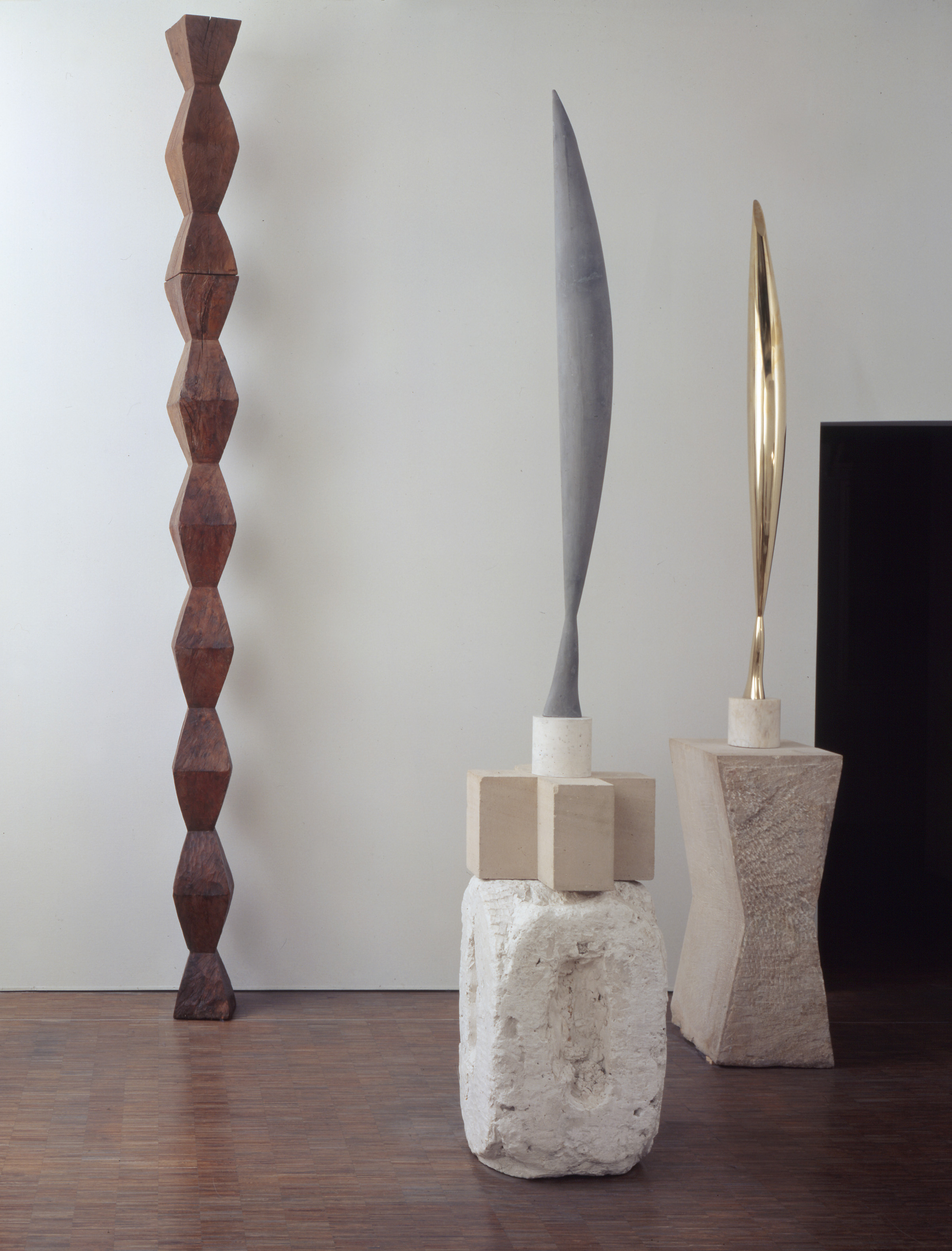
Constantin Brancusi, Endless Column I, ca. 1925. Musée National d'Art Moderne, Centre Georges Pompidou, Paris. Image: © CNAC/MNAM, Dist. RMN-Grand Palais / Art Resource, NY, Artwork: © 2024 Artists Rights Society (ARS), New York
The artist’s use of yellow Plexiglas in the present work also underscored the role of color in his objects, the luminosity and opulence of which opposed the stark geometry of his forms. Following Judd’s discovery of the saturated potential of the medium in the late 1960s, his use of color in the stacks intensified: in Untitled, the reflected tint of the translucent yellow acrylic illuminates the gaps between the units, coalescing form and space into one softly gleaming column of golden light. Moreover, “almost more than any other materials, Plexiglas lived up to Judd’s stipulation that material and color should form a single entity, for color is truly inherent in Plexiglas,” Dietmar Elger clarified. “It is available in an almost endless variety of factory-made colors, and can, in addition, be opaque or transparent, dull, intensely glowing, or even fluorescent.”iv The authenticity of media’s intrinsic hues was key to Judd’s practice, and the silver steel and amber Plexiglas in Untitled exemplify his commitment to material integrity and color's integral role.
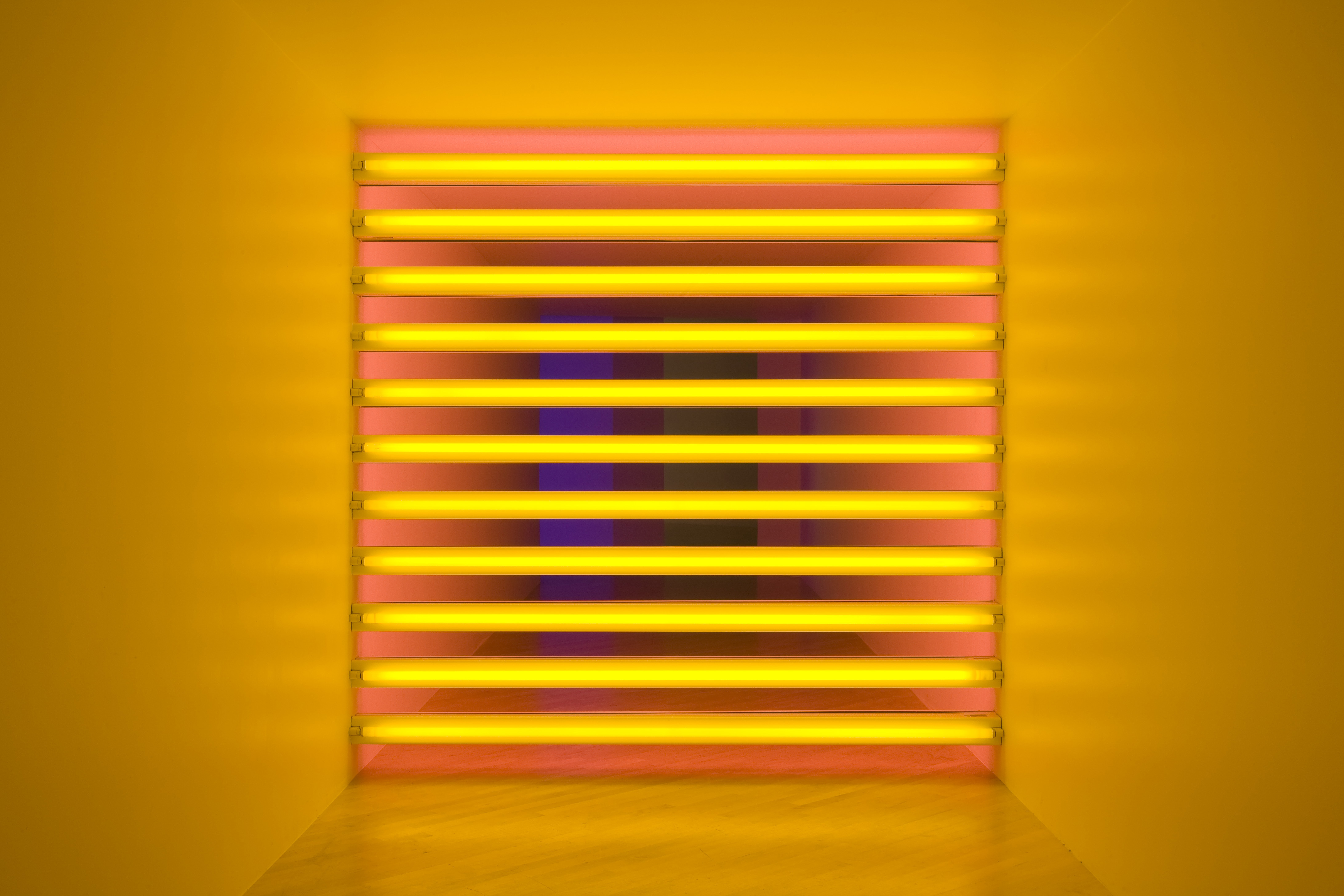
Installation photograph of Dan Flavin: A Retrospective at the Los Angeles County Museum of Art (May 13 - August 12, 2007). Image: © 2024 Museum Associates / LACMA. Licensed by Art Resource, NY, Artwork: © 2024 Stephen Flavin / Artists Rights Society (ARS), New York
Coming to the market for the first time in forty years, Untitled was acquired by Helen Lewis and the late Marvin Meyer not long after the work’s execution, in 1984. Marvin was a celebrated entertainment attorney who co-founded the incredibly influential law firm Rosenfeld, Meyer & Susman. His client roster included many of Hollywood’s biggest names, such as Marilyn Monroe, Muhammad Ali, Grace Kelly, and Billy Wilder—the latter of whom became a particularly close friend of the couple. He also founded, along with Richard Bloch and the singer Andy Williams, the NBA’s Phoenix Suns. From 1974 to 1982, Helen worked as a curator at the Parsons School of Design, New York, and then as the curator and director at the Otis Art Institute in Los Angeles. The couple married in 1979 and became deeply entrenched in the thriving Southern California cultural milieu. From this position, they were able to hone their vision and amass an impressive collection of contemporary art, of which the present work was a cornerstone.
“Color is one of three or four major aspects of my work. I think color is probably the most important aspect of art in this century.”
—Donald Judd
Oscillating between opacity and translucency, solidity and ethereality, Untitled is a pristine testament to the materials and forms of artmaking. In his late masterpieces, Judd attained a sublime lyricism unparalleled in his earlier creations—one which transcends Minimalism’s traditional associations with remoteness and harsh severity. “So-called minimal art is thought of as being cool, impersonal, and reductive,” John Coplans contested. “Judd’s art, however, is not concerned with minimalization, but with a meaningful re-energization of the sculptural vocabulary.”v Achieving the elegant integration of color, material, and space that has driven his entire sculptural practice, Untitled stands as a triumphant culmination of Judd's steadfast quest for the fundamental, immutable truths of artistic creation.
i Donald Judd, “Specific Objects [1965],” in Donald Judd: The Complete Writings, 1959–1975, New York, 2015, p. 184.
ii Donald Judd, quoted in “Don Judd: An Interview with John Coplans,” in John Coplans, Don Judd, exh. cat., Pasadena Art Museum, 1971, p. 36.
iii Barbara Haskell, “Donald Judd: Beyond Formalism,” in Donald Judd, exh. cat., Whitney Museum of American Art, New York, 1988, p. 73.
iv Dietmar Elger, “Introduction (to Don Judd, colorist),” in Donald Judd: Colorist, exh. cat., Sprengel Museum Hannover, 2000, p. 21.
v John Coplans, “Don Judd [1971],” Provocations, ed. Stuart Morgan, London, 1996, p. 113.
Full-Cataloguing
Donald Judd
American | B. 1928 D. 1994Donald Judd came to critical acclaim in the 1960s with his simple, yet revolutionary, three-dimensional floor and wall objects made from new industrial materials, such as anodized aluminum, plywood and Plexiglas, which had no precedent in the visual arts. His oeuvre is characterized by the central constitutive elements of color, material and space. Rejecting the illusionism of painting and seeking an aesthetic freed from metaphorical associations, Judd sought to explore the relationship between art object, viewer and surrounding space with his so-called "specific objects." From the outset of his three-decade-long career, Judd delegated the fabrication to specialized technicians. Though associated with the minimalist movement, Judd did not wish to confine his practice to this categorization.
Inspired by architecture, the artist also designed and produced his own furniture, predominantly in wood, and eventually hired a diverse team of carpenters late in his career.